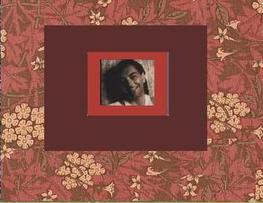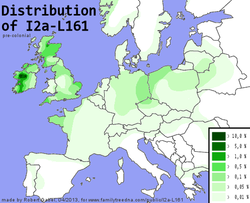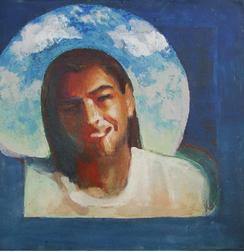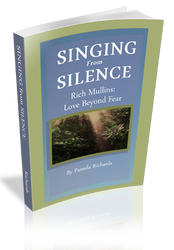
Had he known his ancestral line included Irish kings, I don’t think Richard would have allowed it to change him much. The integrity of his message came first:
“. . . if they fed me like a pauper, or dined me like a prince I don’t care . . .”
Rich Mullins, Elijah
The ancient chieftains of Ireland were not like later imperial kings who owned the very land their subjects subsisted on. The concept of land ownership was foreign to the indigenous Irish. The land was home to the whole clan. The ancient Irish king was truly a servant of his land, his family, and his allies. And if he was not, he would not long remain king of his clan.
Perhaps the Irish value of humility in leadership is the reason fellow Irishman Steve Stockman was so impressed with Richard’s style of leadership:
“. . . we got there just in time to hear a Navaho (sic) High School Choir who were nothing short of awful. It was this that left me with my most challenging memory on the life of Rich Mullins. I turned to Rich at some stage to give him my short and to the point review of the choir. He agreed with my conclusions but went on to inform me that he was going sing "Awesome God" with them and they hadn't rehearsed and it was going to be with a backing track. And so he did. Now why? Why would a man of this stature risk a ropey performance? It seems that it was more important for Rich to give these school kids the thrill of their lives and the sense of dignity of singing with him than it was for him to sound good. It was the first becoming last that the last might somehow be first. It is an act of sacrifice that still slaps the face of my selfishness. . .”
Irish Legends Brought to Life
An ancient Irish King wasn’t necessarily wealthy, but he had a luxury few of us can afford; he had publicity managers who were artists, called bards. Bards observed battles and other newsworthy events, like news journalists sometimes do today. A bard was an expert in the lore of his land who could affect the education and attitudes of others through the skilled use of poetry, storytelling, or song. A king was a man with power, but his actions must make a good impression on his public relations man. The bard could reflect the king’s image back like a mirror and add luster, or focus a light on his actions to reveal flaws. Frequently, the songs and storytelling of the bards were repeated often, and traveled to many counties. A single song could make or break a king.
When history goes back far enough, facts become impossible to verify; the tales repeatedly told tend to crystalize on the deeper truth of the story and over time, these ancient stories are transformed into legends. Yet, behind the potency of legend lies the fact that it condenses a description of human experience we can all find in ourselves, and for this reason it lives through the ages.
I think the thing that would have intrigued Richard most about his kingly tribal line is the rich vein of lore and legend running through it from generation to generation. Scientists may have little use for legends, but they represent great wealth to artists, storytellers and songwriters—those who strive to connect with an audience through the heart.
The legends and lore of Richard's indigenous Irish ancestors are so numerous, with a quality of such depth, that I am only able to briefly recount a few of them here.
* * * * * * * * * *
Amairgin, First Bard of Ireland
Among the earliest of the native Irish named is the legendary first poet of Ireland, Amairgin.
The story is told that he arrived on Ireland by ship. When embarking for the first time upon the island, he celebrated his connection with Nature in this, historically known as the first Irish poem:
The Mystery
I am the wind which breathes upon the sea,
I am the wave of the ocean,
I am the murmur of the billows,
I am the ox of the seven combats,
I am the vulture upon the rocks,
I am a beam of the sun,
I am the fairest of plants,
I am a wild boar in valor,
I am a salmon in the water,
I am a lake in the plain,
I am a word of science,
I am the point of the lance of battle,
I am the God who created in the head the fire.
Who is it who throws light into the meeting on the mountain?
Who announces the ages of the moon?
Who teaches the place where couches the sun?
(If not I)
This isn’t a very Christian poem, but recalling that it has been dated to 1000 BC and that St. Patrick didn’t step foot on the island until about 416 AD, it could hardly be otherwise. It does express a profound empathy with nature, to the point of expressing religious belief. Some believe the degree of nature connection found in indigenous tribes like the native Irish may have taken the form of a shamanism similar to that more recently found in native American tribes.
Richard also was known for his ability to feel the touch of God’s hand in the warmth of a patch of sunlight, or to see the painting of the great Artist in the shade of green He’d chosen for the fields:
“Be praised for all Your tenderness by these works of Your hands
Suns that rise and rains that fall to bless and bring to life Your land
Look down upon this winter wheat and be glad that You have made
Blue for the sky and the color green that fills these fields with praise”
The Color Green, Rich Mullins
* * * * * * * * * *
Tara
Here in America, most of us are familiar with JRR Tolkien’s trilogy, The Lord of the Rings. Tolkien’s Middle Earth was based on the legends of many cultures, from Norse to Anglo Saxon to Germanic. And there is one location in Middle Earth that bears a certain resemblance to an ancient Irish site: Tolkien’s description of Rivendell may have been based on Tara.
Tara of legend served both as the administrative capitol of Ireland, and a center for the arts: it was known to be constantly attended by the Irish songwriters and historians known as bards, musicians, and poets. Its Gaelic name, Te-mur, translates to “Wall of Music,” describing the music of the harp. Its ancient monuments are still to be found just northwest of Dublin.
This passage describes the artistic character of Tara:
“The Dinn Seanchas, or history of noted places in Ireland, compiled by Amergin Mac Amalgaid, in the year 544, relates that in the time of Geide, monarch of Ireland, "the people deemed each other's voices sweeter than the warblings of a melodious harp, such peace and concord reigned among them, that no music could delight them more than the sound of each other's voice: Temur (Tarah) was so called from its celebrity for melody, above the palaces of the world. Tea, or Te, signifying melody, or sweet music, and mur a wall. Te-mur, the ‘wall of music.’ This extract contains the earliest allusion to the harp, which Mr. Hardiman has met with. There is an ancient Gaelic poem which used to be sung in the Highlands of Scotland, in which the poet addresses a very old harp, and asks what has become of its former lustre. The harp replies, that it had belonged to a king of Ireland, and had been present at many a royal banquet; and had afterwards been in the possession of Dargo, son of the Druid of Baal — of Gaul — of Filan, &c. &c. . .”
The harp was not one of the many instruments Richard was known to have mastered. But the notes of the hammered dulcimer, although more staccato, unfold the lingering sustain that builds a similar “Wall of Music” effect. Although the hammered dulcimer is not considered a Celtic instrument, here in America its distinct tones are often heard as representative of both Appalachian and Irish sound.
* * * * * * * * * *
Lugaid Loigde and the Loathly Lady
“. . . the young knight must answer the question "What do women most desire?" The answer, he learns from the old hag, is sovereignty over herself. However, in gaining the answer, he is forced to marry the hag. She then offers him the choice--to have her be pretty and unfaithful, or old but a faithful wife. He wisely allows her to choose, thus demonstraiting (sic) the concept of soveriegnty; at this point, she declairs (sic) that she will be both beautiful and faithful. . .”
“. . .In the older versions, usually found in Irish, the old woman represents the sovereignty of Ireland, and he who submits to her becomes the high king, and marries the sovereignty in a type of hierogamy. There is often a drink involved, which may be connected to the mead and horse cults, as alluded to in various texts, even as late as Gerald of Wales in the 12th century. Here, the sovereignty is a horse goddess who has a cup, often of mead, which she offers to the king; his accepting of the cup seals his kingship and their marriage. . .”
Source
The Legends of the Grail
In the years when I knew him, it seemed to me Richard carried with him his own set of myths and legends, which he would willingly unpack and inhabit in order to bond with those who appreciated them. His timeless sense of connection with legend is one of the themes I’ve attempted to convey in Singing from Silence.
Richard had a lifelong habit of dubbing his close friends with nicknames. He gave me one back in 1974 when we first met. At the time, Wagner’s more updated version of the Loathly Lady was the only one I knew:
“Spooky! I begged him to reconsider the nickname, because everyone else on campus was a Christian and I made no secret of the fact that I was not. I was already standing target practice for the Christian Soldiers who felt a need to practice their evangelism skills; I had no wish to be the subject of a witch hunt.
‘I’ll just tell them I call you that cause you’re so pale,’ he said. And he went on and did just as he pleased.
So when Richard insisted on calling me Spook, I called him Parsifal. I was confident he had enough classical music background to know the story; and he did.”
Singing from Silence, p.20
Back in 1974, I didn’t realize the oldest versions of this tale are told in ancient Irish lore of Richard's ancestral clan:
“. . . in his (Perceval’s) own story there is also a Loathly Lady, though she does not become the Grail Knight's wife; instead, she is often the bearer of the Grail, as well as the chastizer of Perceval for losing his way in the quest. . . ”
This tale is one of the legends of the Grail, a subject of great interest to Richard Mullins in the years when I knew him. Those who have read Singing from Silence will know why I find the Loathly Lady in the Grail legend particularly poignant. The story of Loathly Lady and the Grail King is probably the major theme underlying the book.
From a different time, another continent and a distinct and monotheistic religion, the story of the Song of Songs mirrors the Loathly Lady motif in the reluctance of the Shulamite as she complains about her appearance. She lacks confidence in her worthiness to marry the king so exercises her sovereignty in escaping the palace, only to be mistreated without his protection. At last she realizes she has been in love with the King in disguise as a lowly shepherd all along. And spiritually, this is the story of all of us who exercise our free will by running our own way, only to discover our fulfillment is found in receiving God as our lover and King, not in hiding from him.
The final blog entry in this series is a discussion of a tribute to Irish poet laureate and Nobel Prize winner William Butler Yeats in one of Richard Wayne Mullins' songs, and the ancient legend behind the song.




 RSS Feed
RSS Feed
